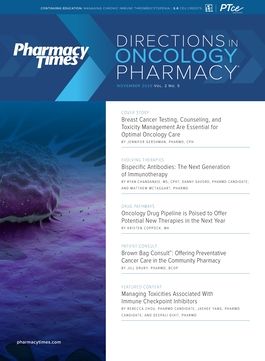Publication
Article
Pharmacy Practice in Focus: Oncology
Best Practices for Safety, Workflow When Using Hazardous Agents
Author(s):
By supplying proper PPE and infrastructure, health systems can keep workers safe and provide excellent patient care.
With many potential exposures to hazardous agents, it is vital that pharmacists and other health care workers interact with these agents safely and implement precautions in their workflow.
In a recent episode of the Pharmacy Times® Practice Pearls video series, experts discussed the challenges that many health care professionals experience when working around hazardous agents and how best to handle them.
Jeffrey Lombardo, PharmD, BCOP, research assistant professor at the University at Buffalo in New York, said health care workers can be exposed to hazardous agents at many points, including receipt, transport, storage, compounding, distribution, administration, and disposal. According to Lombardo, a national survey of nurses has found that more than 50% of nurses had regular exposure to hazardous agents in the workplace.
Catherine Jansen, PhD, RN, AOCNS, an oncology clinical nurse specialist at Kaiser Permanente San Francisco Medical Center in California, agreed that exposure to hazardous agents is a major issue and said the highest risk is dermal because of inconsistent use of personal protective equipment (PPE) and the prevalence of contamination on various surfaces. Jansen said inhalation, ingestion, and injection are less prevalent but should still be carefully avoided.
According to the National Institute for Occupational Safety and Health (NIOSH), 6 criteria are used to define a hazardous drug, including whether it has potential or characteristics of being a carcinogen, whether it is a developmental or reproductive toxicant, whether it is a genotoxicant or a mutagen, whether it is toxic to organs in low doses, and whether the structure and toxicity profile mimic an existing drug. Because many organizations do not have the ability to make these determinations about individual drugs, NIOSH also has a published list of drugs that meet these standards for hazardous.
The risks identified by NIOSH can be minimized in a variety of ways, whether through spaces designed specifically for safety, hoods for ventilation, closed-system transfer devices, and other options. At Kaiser Permanente, Jansen said, they also perform surface wipe sampling, education, and training for employees on how to safely operate around hazardous agents.
Accidental exposure is one of the most common issues, often resulting from a hazardous agent being spread onto a phone or other commonly touched item or through spill responses and splash exposures. Shelley Rae Carry, CIH, CSP, CHMM, HEM, the national environmental health and services principal consultant for Kaiser Permanente, said her facility has developed a comprehensive spill-response guideline based on a 1-liter threshold, with specific protocols in place. They have also provided spill kits with the necessary PPE, labeling for hazardous waste containers, and the 2-page protocol to make sure employees can mitigate any exposures.
Additionally, Carry said processes are in place for employees to seek medical treatment if they are exposed, including a supervisor-first report process and an investigation to find the root cause of the exposure. Additionally, for staff with reproductive concerns, Carry said there is a job accommodation process through human resources.
The experts also addressed workflow and its importance in avoiding and mitigating any contamination of hazardous agents. Although Kaiser Permanente operates as one system, Pamela Leonard, MS, RN, CPPS, senior director of Quality, Safety, and Experience at National Patient Care Services at Kaiser Permanente, said they are in 8 different markets, making workflow infrastructure a challenge.
Leonard said a major part of their system involves coordinating interdisciplinary teams from all regions and creating a governance called the Hazardous Drug Workgroup, which includes subject matter experts and multiple disciplines. The 100-plus committee members meet monthly to discuss key initiatives, get input from operational staff, and hear from medication safety partners.
Corbin Bennett, PharmD, MPH, senior director of oncology services for National Pharmacy Programs and Services at Kaiser Permanente, said that for medical staff handling receipt of new hazardous agents, wiping down the packaging is an essential first step, as several studies have found hazardous drug residue on the packaging. Segregating the drugs from others in storage is also important, whether in refrigerated or nonrefrigerated storage.
Finally, Bennett said proper PPE is an essential aspect of hazardous drug safety. The coronavirus disease 2019 pandemic has, unfortunately, made it more difficult to maintain adequate supplies of PPE, and Bennett noted that there have been cases of spiked prices. In response, he said Kaiser has leveraged remote verification technology, which can allow the pharmacist to check product and medications without entering the hazardous drug buffer room.
Ensuring safety for all medical professionals, staff, and patients is always the utmost priority when dealing with hazardous agents. By providing proper PPE and infrastructure, however, health systems can support this goal while providing excellent patient care.







